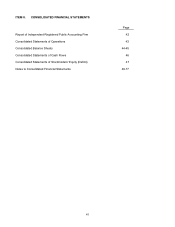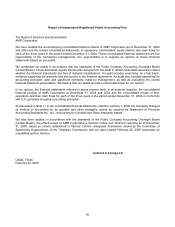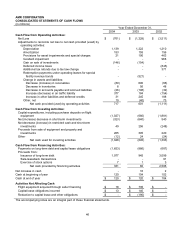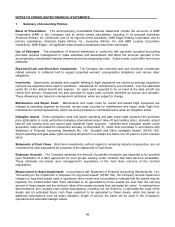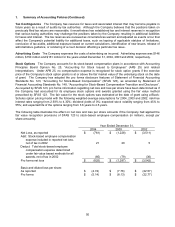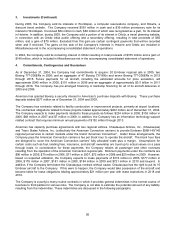American Airlines 2004 Annual Report Download - page 51
Download and view the complete annual report
Please find page 51 of the 2004 American Airlines annual report below. You can navigate through the pages in the report by either clicking on the pages listed below, or by using the keyword search tool below to find specific information within the annual report.
48
NOTES TO CONSOLIDATED FINANCIAL STATEMENTS
1. Summary of Accounting Policies
Basis of Presentation The accompanying consolidated financial statements include the accounts of AMR
Corporation (AMR or the Company) and its wholly owned subsidiaries, including (i) its principal subsidiary
American Airlines, Inc. (American) and (ii) its regional airline subsidiary, AMR Eagle Holding Corporation and its
primary subsidiaries, American Eagle Airlines, Inc., Executive Airlines, Inc. and AMR Leasing Corporation
(collectively, AMR Eagle). All significant intercompany transactions have been eliminated.
Use of Estimates The preparation of financial statements in conformity with generally accepted accounting
principles requires management to make estimates and assumptions that affect the amounts reported in the
accompanying consolidated financial statements and accompanying notes. Actual results could differ from those
estimates.
Restricted Cash and Short-term Investments The Company has restricted cash and short-term investments
related primarily to collateral held to support projected workers’ compensation obligations and various other
obligations.
Inventories Spare parts, materials and supplies relating to flight equipment are carried at average acquisition
cost and are expensed when used in operations. Allowances for obsolescence are provided - over the estimated
useful life of the related aircraft and engines - for spare parts expected to be on hand at the date aircraft are
retired from service. Allowances are also provided for spare parts currently identified as excess and obsolete.
These allowances are based on management estimates, which are subject to change.
Maintenance and Repair Costs Maintenance and repair costs for owned and leased flight equipment are
charged to operating expense as incurred, except costs incurred for maintenance and repair under flight hour
maintenance contract agreements, which are accrued based on contractual terms when an obligation exists.
Intangible Assets Route acquisition costs and airport operating and gate lease rights represent the purchase
price attributable to route authorities (including international airport take-off and landing slots), domestic airport
take-off and landing slots and airport gate leasehold rights acquired. Indefinite-lived intangible assets (route
acquisition costs) are tested for impairment annually on December 31, rather than amortized, in accordance with
Statement of Financial Accounting Standards No. 142, “Goodwill and Other Intangible Assets” (SFAS 142).
Airport operating and gate lease rights are being amortized on a straight-line basis over 25 years to a zero residual
value.
Statements of Cash Flows Short-term investments, without regard to remaining maturity at acquisition, are not
considered as cash equivalents for purposes of the statements of cash flows.
Employee Accruals The Company estimates the amount of potential retroactive pay expected to be provided
upon finalization of a labor agreement for work groups working under contracts that have become amendable.
These estimates are based upon management’s expectation of the most likely outcome of the contract
negotiations.
Measurement of Asset Impairments In accordance with Statement of Financial Accounting Standards No. 144,
“Accounting for the Impairment or Disposal of Long-Lived Assets” (SFAS 144), the Company records impairment
charges on long-lived assets used in operations when events and circumstances indicate that the assets may be
impaired, the undiscounted cash flows estimated to be generated by those assets are less than the carrying
amount of those assets and the net book value of the assets exceeds their estimated fair value. In making these
determinations, the Company uses certain assumptions, including, but not limited to: (i) estimated fair value of the
assets and (ii) estimated future cash flows expected to be generated by these assets, which are based on
additional assumptions such as asset utilization, length of service the asset will be used in the Company’s
operations and estimated salvage values.





